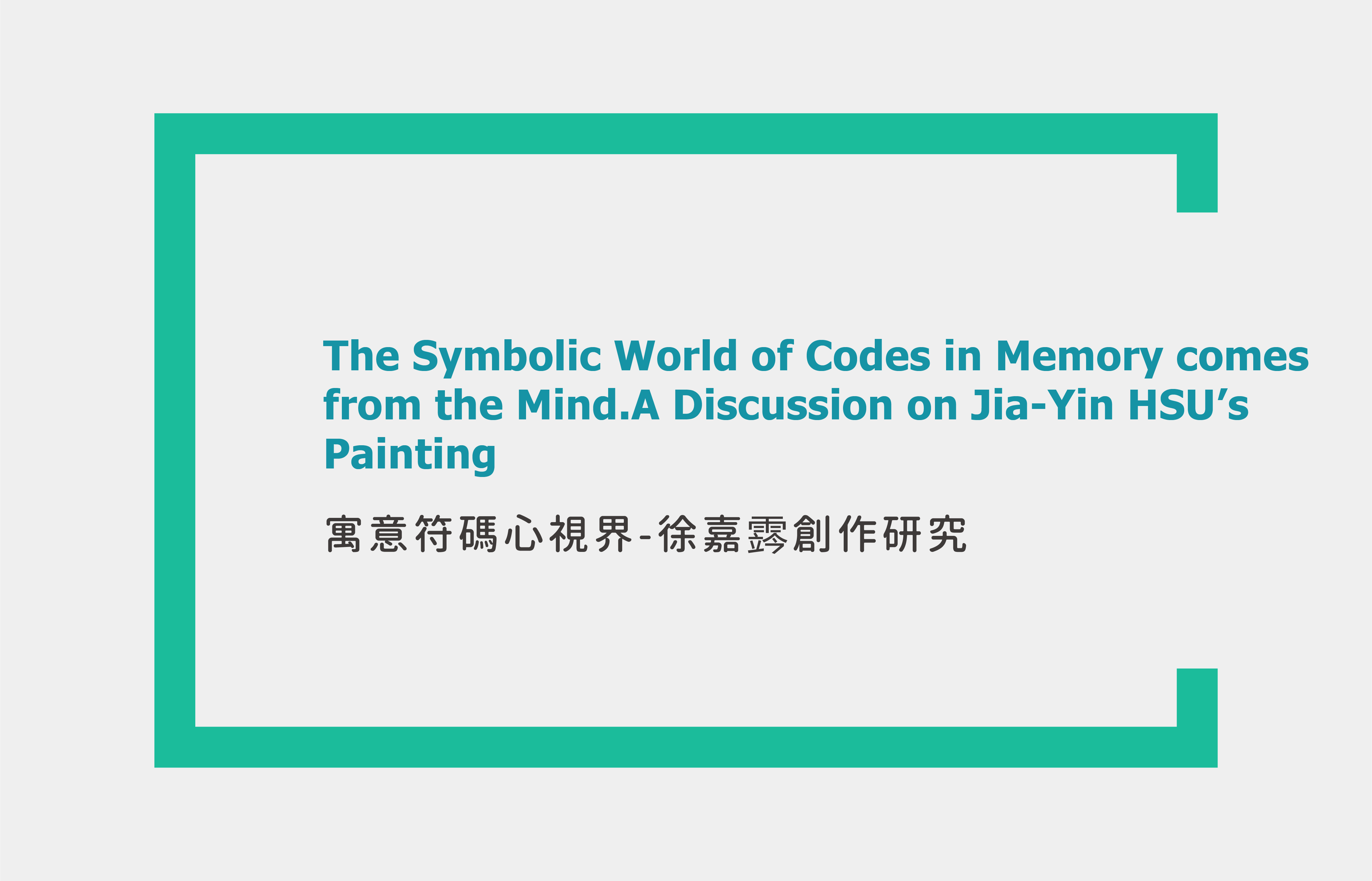寓意符碼心視界-徐嘉霠創作研究
The Symbolic World of Codes in Memory comes from the Mind.A Discussion on Jia-Yin HSU’s Painting.
中文摘要
本論文的主旨為,探究作品中的象徵符碼與深刻記憶之間的關聯性,並思索作者的個人生平背景、生活環境或特別經歷,如何影響「內心的視界」,且何以建立具象徵意圖的「寓憶符碼」,同時進一步分析創作者怎樣透過思維將其編演,並重現在畫作中。期望藉由對作品的解析以提升創作直覺的感悟力,並試圖解構自身與他人、環境、時代間的相互關係,以對生命、記憶滋養更深層的省思。
本文共分五章節,第一章,陳述本論文之研究動機與目的,以及研究內容與方法,並對論文的關鍵字與引用資料加以說明。第二章,藉由文獻中記憶的特性,探索記憶符碼的編列與檢索方式,並透過對藝術家的分析,瞭解藝術創作者的生平遭遇對畫作中的影像寓意之影響,而後藉以影像的解讀來確知其畫作符碼的心像重現與建立。
第三章,進階舉例藝術家在作品中一再出現的寓憶符碼與深刻記憶的相關性,並藉東西方理論與筆者作品的內容取材、草稿繪製、媒材應用等表現方式闡明筆者之理念。第四章,作品解析的部分分為三大系列,其一為「小人物系列」,此系列主要是藉由具象徵寓意的小人物,對生活中的深刻影像進行重新演繹,以傳達畫作理念。其二是「成形印記系列」,此系列則是透過創作媒材的特性來反思生命、人生等記憶中各階段的情境,並運用記憶中相符的符碼以呈現彼此間共通的成形歷程。其三為「心的視界系列」,此系列則是將前兩個系列的寓憶符碼進行延伸,並融合筆者對於時間與人生的思索,從心開始建構屬於自己的視界。第五章「結論」的部分則是進行創作研究的省思,並說明筆者對未來的展望。
Abstract
The dissertation discusses the connection between symbolic codes and meaningful memory in my paintings. This code-memory connection explores a question of how an artist’s personal background, living environment and special experiences to influence an artist’s consciousness of seeing things and to establish visual codes for meaningful memory. Furthermore, the dissertation also analyzes many artists’ thoughts that edit and rearrange visual codes on works of art. Lastly, reviewing my works of art in this dissertation aims to uplift my sensitive sensation while making art pieces. It also leads me to analyze multiple relationships among self, other people, environment and time; hence deeper notions of life and memory coding.
The dissertation has five chapters. Chapter One explains research motivation, research purposes, research fields and methods. Chapter Two is literature review that refers scholarly articles, books and other academic sources relevant to characters of memory, coding and search methods of exploring memory symbols. Literature review also touches upon visualized meaningful message of paintings as a result of an artist’s growing background and living experience. Hence, an artist is able to understand how to reproduce and build visualized consciousness for paintings through image analysis.
Chapter Three mentions some artists as examples of whose works of art surround connections between memory coding and meaningful memory. By following other artists’ examples, literature reviews as well as my art content, drafts and art medium draw a clearly picture of my concept. Chapter Four analyses my three series of works. Minifigures series adopts mini human figures to reinterpret meaningful daily memory. Visible Shapes of Memory series engages a select art medium to reexamine diverse situations that have had happened in my different stages of life. This series presents a common process to form various code-memory connections in my paintings. A Scenario of My Consciousness expands meanings of previous two series and also combines with my ideas of time and life. I aim to build a scenario for my own consciousness from my perception. Chapter Five is the conclusion to rethink the research of my paintings and my perspective on the future.
參考文獻
一、書目
大辭典編撰委員;劉振強 發行,《大辭典》(臺北市:三民書局股份有限公司,1985年8月)。
史奎爾(Larry R.Squire),肯戴爾(Eric R.Kandel)合著;洪蘭譯:《透視記憶》(臺北市:遠流出版社,2001年)。
佛洛伊德(Sigmund Freud)著;劉平、孫慶民等譯,《達文西對童年的回憶》(臺北市:胡桃木文化出版,2006年10月第一版)。
佛洛伊德著;孫名之譯,《夢的解析》(新北市:左岸文化出版,2010年初版)。
李明明,《古典與象徵的界線─象徵主義畫家莫侯及其詩人寓意畫》(臺北市:東大發行,1993年12月初版)。
柳淳風,《達利》(北京市:中國人民大學出版社,2004年9月)。
約翰.伯格著;吳莉君譯,《觀看的方式》(臺北市:麥田城邦文化出版社,2010年8月)。
凌嵩郎,《藝術概論》(臺北市:藝術家出版社,1982年) 3。
陳傳席,《中國繪畫理論史》(臺北市:三民書局,1997年9月)。
陳蒲清,《寓言文學理論、歷史與應用》(新北市:駱駝出版社,1987年)。
湯瑪斯 R 布雷克(Thomas R. Blakeslee) 著;鄭辰白譯,《右腦革命》(臺北市:業強出版社,1986年10月初版)。
葉重新,《心理學》(臺北市:心理出版社,2011年5月四版)。
葉朗,《中國美學史大綱》,(上海市:上海人民出版社,2009年)。
潘襎,《采風.神韻.李奇茂》(臺中市:國立台灣美術館,2014年12月初版)。
韓叢耀,《圖像傳播學》(臺北市:威仕曼文化出版,2005年9月初版)。
麗塔.卡特(Rita Carter)著;洪蘭譯,《大腦的秘密檔案》(臺北市:遠流出版,2002年初版)。
Elizabeth Loftus、Katherine Ketcham著;洪蘭譯:《記憶vs.創憶:尋找迷失的真相》(臺北市:遠流出版,2010年2版)。
Gillian Rose著;王國強譯,《視覺研究導論─影像的思考》(臺北市:群學出版社,2006年7月一版2印)。
二、論文
陳宜蓁,〈王鼎鈞散文的寓言體書寫研究〉(國立臺灣師範大學國文學系教學碩士班碩士論文,102年8月)。
陳建樺,〈視覺修辭應用於閒章藝術研究與創作〉(國立台灣藝術大學美術學院書畫藝術學系碩士在職專班碩士論,102年6月)。
三、作品集、圖錄
石田徹也,《石田徹也作品全集》(東京:求龍堂出版,2010年5月)。
何政廣,《世界名畫家全集-達文西》(臺北市:藝術家出版社,1999年6月)。
吳澤義,《西洋名畫家達文西》(臺北市:藝術圖書公司印行,1997年4月)。
侯忠穎等人合著,《2015鴻梅新人獎 巡迴展作品集》(新竹市:鴻梅文化藝術基金會,2015年7月)。
胡永芬,《幻想國度之神-達利》(新北市:閣林國際圖書有限公司,2001年1月)。
陳順築,《硓咕山陳順築個展》(臺北市:台北市立美術館,2016年1月)。
潘襎,《采風.神韻.李奇茂》(臺中市:國立台灣美術館,2014年12月)。
Bruno Santi ,Leonardo da Vinci , Riverside Book Company , 1975。
Silvia Borghesi ,art book-Dali ,Elecata Bolsillo ,2004。
四、網路資源
石田徹也展実行委員会。(2016年)飛人- 石田徹也世界。【官方網站】取自:reservedhttp://tetsuyaishida.jp/71843/?lang=ja
中華民國教育部(104年11月網路第五版),《重修國語辭典修訂本》【線上辭典】。取自:http://dict.revised.moe.edu.tw/cbdic/index.html
黃立佩(2011年10月11日)。石田徹也,超現實之社會寫實【線上論壇】。取自:http://blog.roodo.com/artlipei/archives/17326151.html
張禮豪(2015年02月03日)。用影像道出沒有故事的故事:陳順築【線上論壇】。取自:http://passage.life/2015/02/chen_shun-chu/
維基百科(2016年7月7日修訂)。象徵主義【線上百科全書】。取自:https://zh.wikipedia.org/wiki/%E8%B1%A1%E5%BE%81%E4%B8%BB%E4%B9%89
